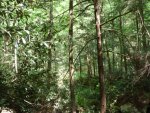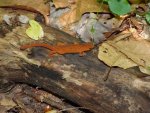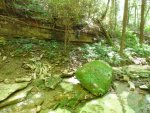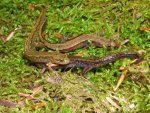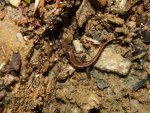Aneides Aeneus
New member
- Joined
- Nov 16, 2014
- Messages
- 30
- Reaction score
- 3
- Points
- 0
- Location
- Lexington, Kentucky
- Country
- United States
Hey guys,
Since I haven't posted in a while, I though I should post some photos from a recent trip I made to a waterfall in Eastern Kentucky, with some very diverse habitats for salamanders. Below the waterfall is a small stream running through a steep valley with moist deciduous forests. The stream runs through layers of shale. Because of the way shale chips, this creates many flat rocks in the stream under which one can find salamanders. The edges of the valley consist of tall cliffs, with limestone in the lower layers, and sandstone in the upper layers. So far we have found red, spring, cave, longtail, two-lined, seal, northern dusky, black mountain dusky, green, and slimy salamanders at this location, as well as red efts.
1. A spotted salamander found very nearby. Above the waterfall, there may potentially be spotted salamanders, due to the presence of small vernal pools near the stream. There we found a hatched egg mass which resembled a spotted salamander egg mass, although we aren't sure.
2. The base of the waterfall. Each time we come here, we see hundreds of seal salamanders in crevices and under pebbles in the splash zone.
3. Seal salamanders in the crevices below the waterfall. These are by far the most common salamander at this site.
4. A green salamander found in the cliffs near the waterfall. The are fairly common in slightly moist, sandstone crevices, but are absent from shale and limestone.
5. A northern dusky salamander. Although they are fairly common, they are nowhere near as common as seal salamander in Eastern Kentucky.
6. A black mountain dusky salamander. This is a somewhat uncommon species restricted to Eastern Kentucky and neighboring areas. It prefers small, steep, shaded creeks. They can get much larger than the other dusky salamanders in the region. Note the thick jaws in the photo.
7. A cave salamander found in a small cave enterance in the limestone layers near the waterfall. Longtail and slimy salamanders are also common in this habitat.
8. A two-lined salamander found in the stream.
-Ananth.
Since I haven't posted in a while, I though I should post some photos from a recent trip I made to a waterfall in Eastern Kentucky, with some very diverse habitats for salamanders. Below the waterfall is a small stream running through a steep valley with moist deciduous forests. The stream runs through layers of shale. Because of the way shale chips, this creates many flat rocks in the stream under which one can find salamanders. The edges of the valley consist of tall cliffs, with limestone in the lower layers, and sandstone in the upper layers. So far we have found red, spring, cave, longtail, two-lined, seal, northern dusky, black mountain dusky, green, and slimy salamanders at this location, as well as red efts.
1. A spotted salamander found very nearby. Above the waterfall, there may potentially be spotted salamanders, due to the presence of small vernal pools near the stream. There we found a hatched egg mass which resembled a spotted salamander egg mass, although we aren't sure.
2. The base of the waterfall. Each time we come here, we see hundreds of seal salamanders in crevices and under pebbles in the splash zone.
3. Seal salamanders in the crevices below the waterfall. These are by far the most common salamander at this site.
4. A green salamander found in the cliffs near the waterfall. The are fairly common in slightly moist, sandstone crevices, but are absent from shale and limestone.
5. A northern dusky salamander. Although they are fairly common, they are nowhere near as common as seal salamander in Eastern Kentucky.
6. A black mountain dusky salamander. This is a somewhat uncommon species restricted to Eastern Kentucky and neighboring areas. It prefers small, steep, shaded creeks. They can get much larger than the other dusky salamanders in the region. Note the thick jaws in the photo.
7. A cave salamander found in a small cave enterance in the limestone layers near the waterfall. Longtail and slimy salamanders are also common in this habitat.
8. A two-lined salamander found in the stream.
-Ananth.
Attachments
-
 P1030141_Spottedsm.JPG345.9 KB · Views: 1,547
P1030141_Spottedsm.JPG345.9 KB · Views: 1,547 -
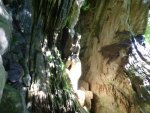 P1030173sm.JPG307.9 KB · Views: 691
P1030173sm.JPG307.9 KB · Views: 691 -
 P1030165_Sealsm.JPG351.8 KB · Views: 598
P1030165_Sealsm.JPG351.8 KB · Views: 598 -
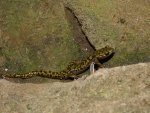 P1030190_Greensm.JPG368.1 KB · Views: 633
P1030190_Greensm.JPG368.1 KB · Views: 633 -
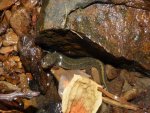 P1030199_NorthernDuskysm.jpg156.7 KB · Views: 641
P1030199_NorthernDuskysm.jpg156.7 KB · Views: 641 -
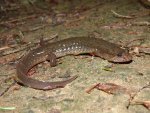 P1030207_BlackMountainDuskysm.JPG319.8 KB · Views: 975
P1030207_BlackMountainDuskysm.JPG319.8 KB · Views: 975 -
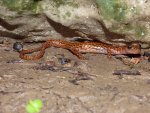 P1040006_Cavesm.JPG357.8 KB · Views: 784
P1040006_Cavesm.JPG357.8 KB · Views: 784 -
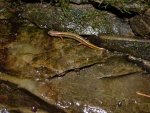 P1040008_TwoLinedsm.jpg159.3 KB · Views: 964
P1040008_TwoLinedsm.jpg159.3 KB · Views: 964

